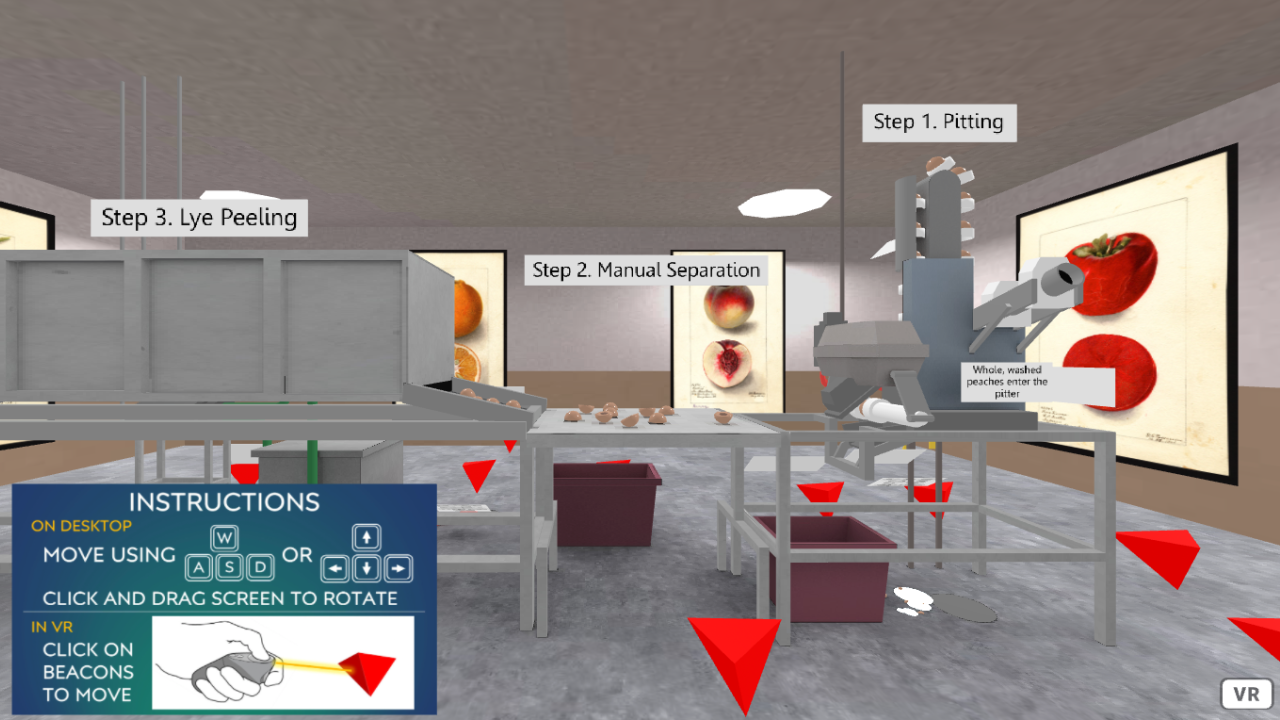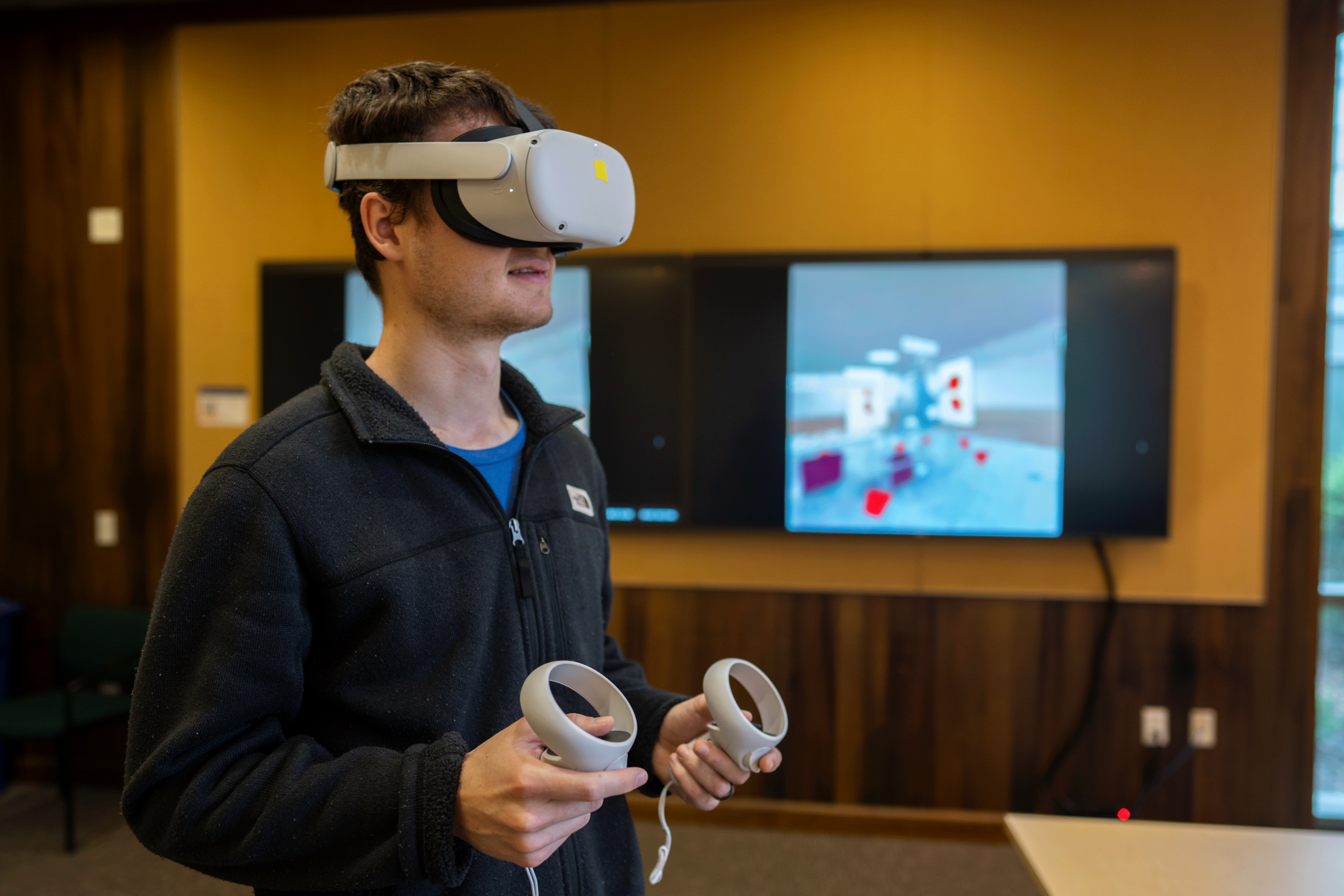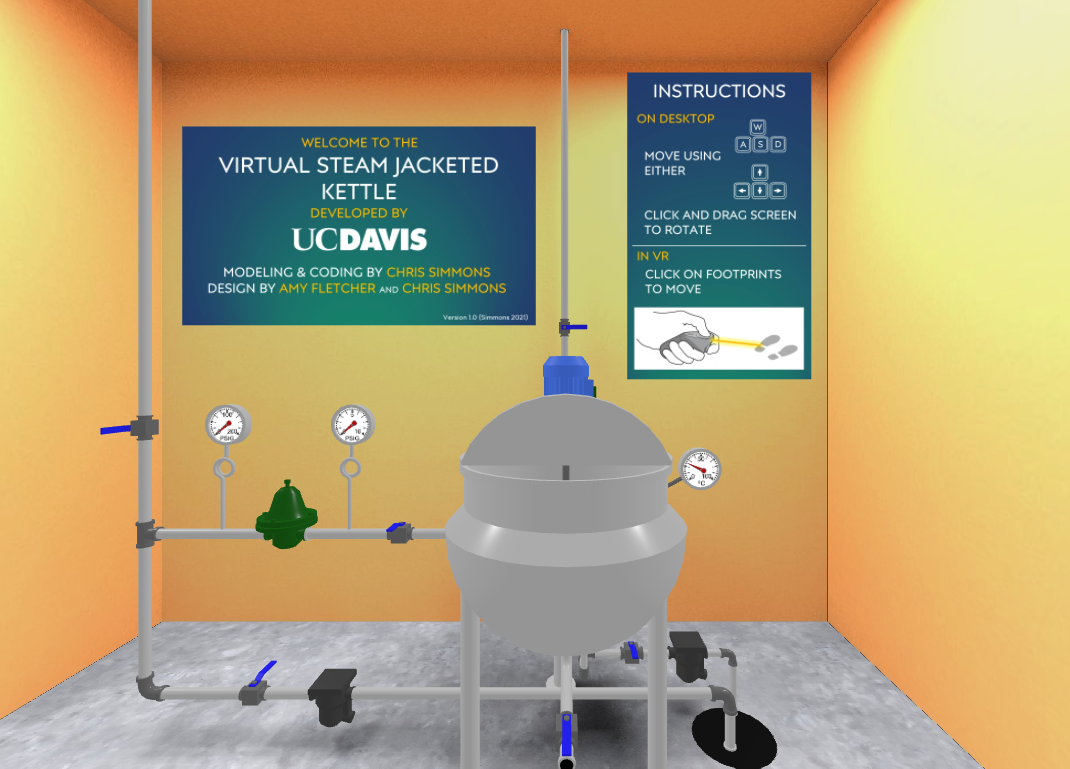
Professor develops technique to create immersive food processing environments
In a peach processing facility, the air might be filled with the sweet aroma of ripe peaches and the sound of equipment humming as it carries out the canning process. At the California Processing Tomato Industry Pilot Plant on campus, students within the Department of Food Science and Technology (FST) get to see that action firsthand. They can also now experience it – virtually.
FST Chair and Professor Christopher Simmons developed several virtual reality (VR) modules to help teach students about the intricacies of food processing. Simmons, who earned bachelor’s, master’s and doctorate degrees in engineering, created virtual environments featuring various pieces of real-life equipment that the food industry uses to wash, sanitize, heat and perform other operations to produce food products.
“We use it to bring more interactive and immersive learning opportunities into the lesson plan, beyond what you can get with images, videos or written descriptions, and to better communicate the spatial reasoning behind the design of the equipment and facilities,” Simmons said.

Pandemic sparks tech innovation
Simmons first introduced the technology during the height of the COVID-19 pandemic, when instruction was fully remote.
“We were using it as an emergency alternative to our traditional lab activities during the pandemic because we had no ability to engage with the real equipment or facilities we typically rely on,” Simmons explained. When in-person learning resumed, Simmons kept the VR component alive, and it complements his in-person training.
There’s no app, it’s just streaming VR, accessed via websites using a device of choice, such as a computer, tablet or cell phone. Students can also visit the virtual settings using a VR headset for a full 3-dimensional, immersive experience.
Simmons said he’s incorporated the VR models into his undergraduate courses, FST 110 – physical principles in food processing and FST 110L – food processing lab, and graduate course, FST 228 – food systems and sustainability. In these courses, students use the virtual environments in class and at home on their computers for homework assignments and to reinforce concepts covered in lecture.
“When I ask students if they’ve used it, they’re always excited to use this new technology,” said Shayne Morrissey, Ph.D. student and teaching assistant with the Department of Food Science and Technology.

Navigating digital replicas
Currently, there are several virtual environments being used by students. Simmons created a virtual replica of the campus’ anaerobic digestor, a milk processing facility, a steam-jacketed kettle, a centrifugal pump, and a flume washer.
There’s also a virtual peach processing facility, which is the largest VR model and a complete replica of the peach line found in the Pilot Plant on campus. There, students can experience the whole process from start to finish. The virtual model describes the flow of the fruit material and what happens at each step.
Students learning how to use a steam-jacketed kettle, which is a common piece of equipment for heating things up, get to operate the valves and read the gauges virtually before seeing it in person.
“This is the most interactive virtual environment we have because you can adjust all the valves and get readings off the gauges, just as you would in real life,” Simmons explained.
During a demonstration, Morrissey wore a VR headset to show what it was like to experience the kettle room. At one point, Simmons instructed him to walk forward and turn open a valve on a pipe coming from the ceiling to allow water to flow into the tank. “That’s so cool,” Morrissey expressed. He could also see a thermometer that showed the needle going up as the water inside the kettle was “warming” up.
“This is an exact facsimile of how you would operate this kettle that we have in the Pilot Plant, displaying data that we would obtain from the genuine piece of equipment, so this is our most advanced virtual module where you are really interacting in a way that’s entirely representative of the actual equipment,” Simmons said.
Morrissey also showed off the virtual room with a flume washer, which is often used to wash produce. Simmons suggested he “dip” his hand in the water in the sink.
“A lot of students have fun with that, I tell them to be careful not to fall over,” Morrissey quipped.
Less noise, better safety
There are some benefits to using the VR modules before exposing students to the real deal. For instance, the real peach canning facility can be very loud when the equipment is running, which limits the amount of conversation that can be had.
“It’s tremendously loud, so it’s hard to instruct in the moment and students can’t readily converse within their groups. And you’ve got to be careful because there are moving parts in the peach pitter and caustic solution being used to peel the peaches. So, there are some safety concerns that we have to always be mindful of,” Simmons said. “None of that exists in the virtual space.”
Future purposes
In addition to using it as a teaching tool, Simmons and Morrissey are working with FST Professors Nitin Nitin and Bwalya Lungu, along with collaborators at the University of Maryland, to study the effectiveness of VR learning. There’s one research project underway to determine if using these VR modules within food processing coursework broadly improves motivation to learn. Another study in the works is analyzing if communication of 3-dimensial concentration data in produce washing for sanitizer can be better conveyed in virtual environments compared with the traditional color-map/concentration map typically depicted in 2-dimensions.
Simmons said there’s no limitation to what can be created in the virtual world. He has some ideas for possible future models, including a virtual exploration of chemical and microbial aspects in soil.
“This is still very new technology, especially in food science,” Simmons said. “The opportunities are boundless.”
Media Resources
- Christopher Simmons, Department of Food Science and Technology, cwsimmons@ucdavis.edu
- Shayne Morrissey, Department of Food Science and Technology, sgmorrissey@ucdavis.edu
- Tiffany Dobbyn, College of Agricultural and Environmental Science, tadobbyn@ucdavis.edu
